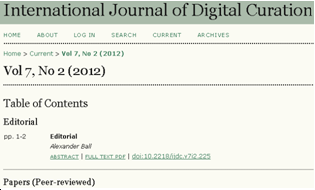
International Journal of Digital Curation, Volume 7, Issue 2
The International Journal of Digital Curation, Volume 7, Issue 2 was recently published by UKOLN on behalf of the Digital Curation Centre. It contains the usual mix of peer-reviewed papers and general articles; eight derive from papers presented at the 2011 International Digital Curation Conference, while two were new contributions received by the Journal through general submission.
The general articles in this issue give a flavour of the broad range of issues surrounding good research data management. On the technical side, there are two articles that describe how specialist systems were designed and implemented to support researchers in managing their data. For MaDAM, described by Poschen et al., the target audience was researchers in a single institution while for TR32DB, described by Curdt et al., the target was a single project, though a multidisciplinary and multi-institutional one.
Bridging the gap between technical systems and human infrastructure, Sallans and Donnelly compare and contrast DMP Online and DMPTool, two services that assist researchers in their data management planning. Molloy and Snow, meanwhile, concentrate on the researchers themselves, and the skills and training they need in order to manage their data effectively. They provide a list of recommendations that should be useful for anyone designing data management training courses.
At this time of economic uncertainty, research data management has to fight for funding among many other priorities. It is timely, therefore, for Beagrie et al. to give an overview of the Keeping Research Data Safe (KRDS) Benefit Analysis Toolkit. It consists of a pair of tools for identifying the benefits of data management and evaluating its impact.
It is in everyone's interest for the scientific record to be of a high standard and sufficiently comprehensive. Grootveld and Egmond describe a pilot project that is encouraging people downloading data from the EASY archive at DANS to provide reviews: exactly the kind of information needed to determine whether data are being delivered in an intelligible and usage state. Littuer et al. champion another research output often lacking from the record, the automated scientific workflow. They provide recommendations on how to share and promote workflows in order to maximise their impact.
The three peer-reviewed papers are linked by a different thematic chain. Digital forensics groups together tools, techniques and formats that are used when extracting information from digital devices for use in court as evidence. Kim and Ross argue that the archival forensic file (aff) format should be seriously considered by digital repositories as an archival storage format. Knight, meanwhile, suggests some forensic tools and techniques that may come in useful when a institutional archive has, for example, the task of ingesting the personal digital archive of a departed academic. Rescuing legacy data is also the concern of Brown, who describes a system giving access to early interactive CD-ROM titles aimed at pre-OS X Mac platforms. This extends a system originally used for Windows-based CD-ROM titles, reported by the Journal back in Volume 5.
To read Volume 7, Issue 2 of the IJDC, please visit the Journal Web site.
Note: You can find latest updates on our home page and previous articles in Feature archive.